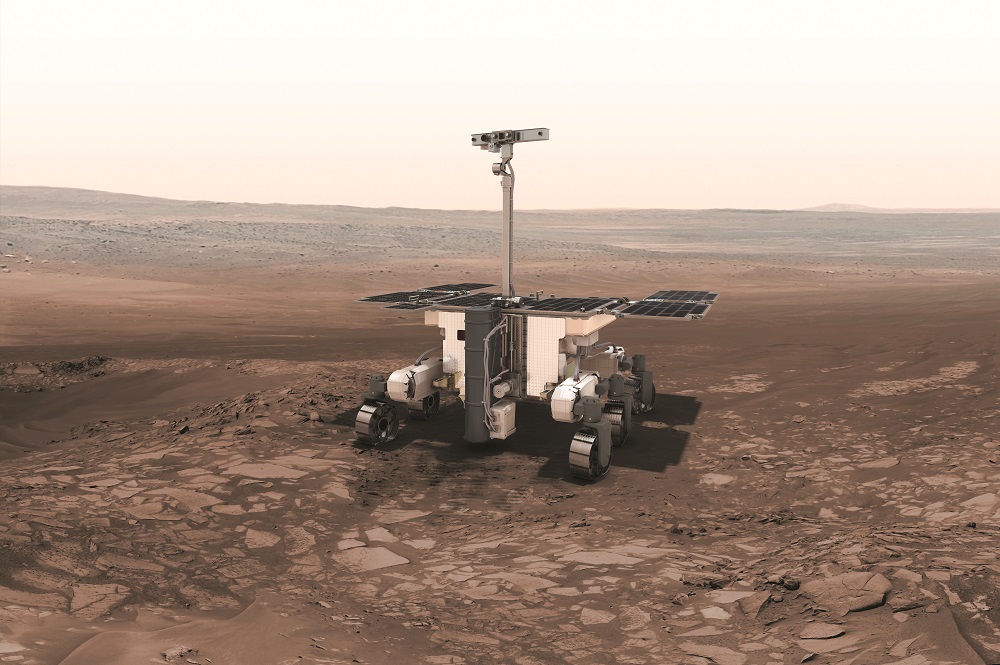WASHINGTON — After missing its initial launch window in 2020 in part because of the pandemic, the European Space Agency’s ExoMars mission is on schedule for a launch in September.
ESA said Jan. 18 preparations for the mission, which will land a rover named Rosalind Franklin on the surface of Mars, are on track for a launch between Sept. 20 and Oct. 1 on a Proton rocket from the Baikonur Cosmodrome in Kazakhstan. The rover and the Kazachok surface platform, provided by Roscosmos, will land in the Oxia Planum region of Mars in June 2023.
ExoMars was scheduled to launch in mid-2020. However, problems with the parachutes that will slow down the spacecraft in the Martian atmosphere, as well as complications caused by the onset of the pandemic, led ESA to postpone the launch in March 2020.
ESA now believes it has solved the problems with the parachutes after some assistance from NASA. In December, ESA conducted high-altitude tests of the parachutes in Oregon, successfully deploying two different versions of the larger of the lander’s two parachutes, 35 meters in diameter.
The rover itself has completed tests, with what ESA described in a statement as only “some minor tuning” left to do. “The rover is ready, and together with the recent drop test success for the parachutes, we are positive to be in time for the September launch date,” Pietro Baglioni, ESA ExoMars rover team leader, said in the statement.
At a press conference the same day, ESA Director General Josef Aschbacher also expressed confidence about ExoMars. “It’s going very well,” he said. “We are on a good track with a small positive launch schedule margin.”
Those preparations, officials said, included repairing electronics on the descent module of the spacecraft. “It controls the main braking engine for the final landing on the surface of the red planet, and it’s one of the elements that caused the delay of the launch back in 2020,” said David Parker, director of human and robotic space exploration at ESA. There are ongoing tests of the electronics as well as software changes, he said.
One factor that could complicate launch plans is rising geopolitical tensions between Russia and the West over concerns Russia is preparing to invade Ukraine. Aschbacher said that he hoped those would not affect cooperation with Russia in space, including the ExoMars launch. “What happens politically on the ground will not change any of the plans towards the launch,” he said.
Astronaut selection
Another major initiative for ESA in 2022 is selection of a new class of astronauts. The agency announced Jan. 18 that it completed the first stage of the selection by reviewing the 23,307 applications it received. That review reduced the candidate pool to 1,362 people, who will now undergo a series of physical and personality tests.
Those tests, starting in February, will reduce the pool to about 400 people, Aschbacher said. Further tests will result in a “few tens” of finalists that he said he will personally interview before the agency selects four to six astronauts by the end of the year.
That initial selection process took longer than expected because the agency received far more applications than expected. “It shows that space is getting a new renaissance in terms of attractiveness,” he said.
ESA is also reviewing applications from “para-astronaut” candidates who have some physical limitations. The agency received 287 such applications, of which 29 have been selected for further tests. “We would like to enable people with some disabilities to also be able to fly to space,” he said.
Ariane 6 uncertainty
The year is scheduled to see the debuts of two new launch vehicles, the Vega C and Ariane 6. However, while the Vega C appears set to launch in May, Aschbacher was more tentative about the prospects of an inaugural Ariane 6 launch this year.
“Today, I’m not in a position to give you an exact maiden flight launch date,” he said, because of two upcoming series of tests: hot-fire tests of the upper stage at a facility in Lampoldshausen, Germany, scheduled to start in February as well as combined tests of the core and upper stages of the rocket at the spaceport in Kourou, French Guiana. Those two stages arrived in Kourou this week.
Those tests, he noted, could result in additional work on the vehicle before it is cleared for its first launch. “If everything goes according to plan, we launch this year,” he said, “but as I said, there two milestones are critical and, only after having passed them, we can consolidate a maiden flight launch date for sure.”
Daniel Neuenschwander, director of space transportation at ESA, offered a similar assessment on the schedule for Ariane 6. “Both of these technical milestones bear a certain level of risk,” he said of the upcoming tests. “This is why we have to go through these two major campaigns before announcing definitely the date.”
“We are really on the final path of development of the Ariane 6,” he added. “We’ll do everything to make it as soon as possible.”
